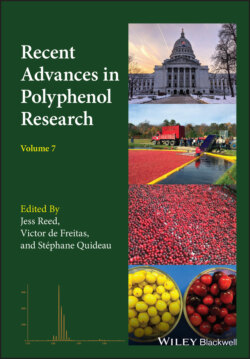Читать книгу Recent Advances in Polyphenol Research - Группа авторов - Страница 29
2.2 Structure
ОглавлениеThis section describes a brief history of the oligomeric PAs with A‐type linkages. In 1966, Mayer and coworkers isolated a crystalline phenolic compound from the seed shells of a horse chestnut (Aesculus hippocastanum L.). Using mass spectroscopy, the chemical composition was determined to be C30H24O12 (Mayer et al. 1966). The compound was hydrolyzed with conc. hydrochloric acid, and paper chromatography identified two hydrolysates, epicatechin (1) and cyanidin (2) (Figure 2.4). At this stage, the compound was named procyanidino‐(–)‐epicatechin without specifying the parent dimer structure. Three possible dimeric structures, I–III, were postulated, sharing a common feature that two epicatechin units are linked through a double linkage. They stated that, among these, the structure III would be most likely.
Figure 2.3 Origin of the structural diversity in oligomeric PAs: compounds having the A‐type connectivity.
Figure 2.4 Acid hydrolysates of the dimeric proanthocyanidin isolated from Aesculus hippocastanum, and three possible dimeric structures proposed by Mayer.
Later, Weinges and coworkers extracted several related compounds from cranberries (Vaccinium vitis‐idaea), which included the “Mayer's dimer” mentioned above (Weinges et al. 1968). They arbitrarily classified those compounds into two categories by the number of hydrogen atoms (Figure 2.5): the dimeric proanthocyanidin compounds with molecular formula C30H24O12 as the A‐type, and those with C30H26O12 as the B‐type. Thus, the above‐stated Mayer's compound, i.e. procyanidino‐(–)‐epicatechin, was renamed procyanidin A2.
Haslam and coworkers later proposed the currently accepted structure 3 (Figure 2.5a) with a characteristic bicyclic skeleton formed by two interflavan bonds {C(4)–C(8) and C(2)–O[C(7)]} based on the 1H‐ and 13C‐NMR data and some chemical evidences (Jacques et al. 1973, 1974). A decade later, the structure was unequivocally verified by X‐ray crystallography (Van Rooyen and Redelinghuys 1983).
With advances in the separation and analytical methods, the more complicated oligomeric PAs having A‐type linkages have been identified from various plant sources. Figure 2.6 shows some of the tetramers with A‐type structure, which are homo‐ or hetero‐oligomers (Nonaka et al. 1983; Morimoto et al. 1985; Morimoto et al. 1987; Balde et al. 1995; Nam et al. 2017). It should be noted that the molecular diversity arises not only from the elements stated before, but also from the inclusion of the enantiomeric flavan‐3‐ols (e.g. ent‐AZ, ent‐EC, ent‐CA in pavetannin C5) as constituent monomers. The diversity will increase in the future, and some of these compounds may show potentially significant biological activities.
